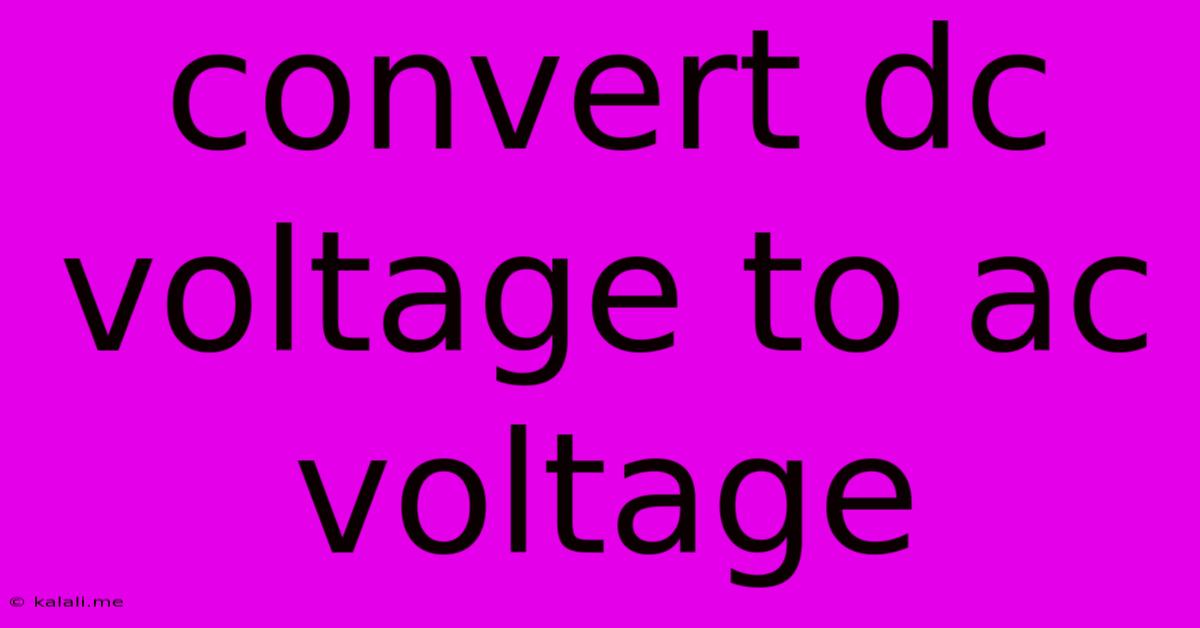Convert Dc Voltage To Ac Voltage
Kalali
May 22, 2025 · 3 min read

Table of Contents
Converting DC Voltage to AC Voltage: A Comprehensive Guide
Meta Description: Learn how to convert DC voltage to AC voltage using various methods, including inverters, oscillators, and other circuits. This comprehensive guide explores the principles, applications, and considerations for each approach.
Converting direct current (DC) voltage to alternating current (AC) voltage is a fundamental process in electronics with numerous applications. From powering household appliances using solar panels to running AC motors from DC batteries, the ability to efficiently transform DC to AC is crucial. This guide explores the common methods for achieving this conversion, outlining their principles, advantages, and disadvantages.
Understanding the Difference: DC vs. AC
Before diving into the conversion methods, it's important to understand the core difference between DC and AC. DC voltage flows consistently in one direction, while AC voltage periodically reverses its direction. This reversal happens at a specific frequency, typically 50 or 60 Hertz (Hz), which represents the number of complete cycles per second.
Methods for DC to AC Conversion
Several methods are employed to convert DC to AC, each with its own set of characteristics and suitability for specific applications:
1. Inverters:
- Principle: Inverters are the most common method for DC-to-AC conversion. They use electronic switching circuits to rapidly switch the DC voltage on and off, creating a square wave output. This square wave is then often filtered to produce a smoother sine wave, approximating the sinusoidal waveform of standard AC power.
- Types: Inverters come in various types, including those producing modified sine waves and pure sine waves. Pure sine wave inverters generally provide cleaner power, better suited for sensitive electronic devices.
- Applications: Inverters are widely used in various applications, including power supplies for laptops and other electronics, uninterruptible power supplies (UPS), and solar power systems.
- Advantages: High efficiency, relatively inexpensive, readily available.
- Disadvantages: Can generate harmonic distortion, especially with modified sine wave inverters.
2. Oscillators:
- Principle: Oscillators generate AC signals using feedback circuits. By utilizing components like operational amplifiers (op-amps) and transistors, oscillators can produce AC waveforms of different shapes and frequencies from a DC power supply.
- Types: Different oscillator types exist, such as relaxation oscillators and sinusoidal oscillators, each with varying output characteristics.
- Applications: Oscillators find applications in signal generation, timing circuits, and various electronic instruments.
- Advantages: Can generate various waveforms, precise frequency control.
- Disadvantages: Circuit design can be complex, often requires specialized components.
3. Chopper Circuits:
- Principle: Chopper circuits use high-speed switching to create a pulsed DC output from a DC input. This pulsed DC can then be filtered to produce an AC output, though usually not a clean sine wave.
- Applications: Often used in DC motor speed control and power supplies.
- Advantages: High efficiency in some applications.
- Disadvantages: Output waveform may not be ideal for all AC loads.
Choosing the Right Method
The best method for DC-to-AC conversion depends on several factors:
- Power Requirements: The amount of power needed will influence the choice of inverter or other circuit components.
- Waveform Quality: For sensitive electronics, a pure sine wave inverter is generally preferable.
- Cost: Inverters are typically a cost-effective solution for many applications.
- Efficiency: Different methods have varying efficiency levels.
- Frequency Requirements: The desired frequency of the AC output will dictate the design of the oscillator or inverter circuit.
Safety Considerations
Working with electricity always requires caution. When dealing with DC-to-AC conversion, proper safety measures are essential to prevent electrical shock or damage to equipment. Always ensure proper grounding, use appropriate safety equipment, and follow manufacturer instructions.
Conclusion
Converting DC voltage to AC voltage is a fundamental process with diverse applications. Understanding the different methods and their characteristics allows for informed decision-making in selecting the optimal solution for a specific need. Careful consideration of power requirements, waveform quality, cost, efficiency, and safety is crucial in designing and implementing a reliable and effective DC-to-AC conversion system.
Latest Posts
Latest Posts
-
French Movies With English And French Subtitles
May 22, 2025
-
Wiring Diagram For Nest Heat Link
May 22, 2025
-
How Do You Say I Am Spanish
May 22, 2025
-
Is The Following Statement True Or False
May 22, 2025
-
Does Speed Limit Apply To Cyclists
May 22, 2025
Related Post
Thank you for visiting our website which covers about Convert Dc Voltage To Ac Voltage . We hope the information provided has been useful to you. Feel free to contact us if you have any questions or need further assistance. See you next time and don't miss to bookmark.